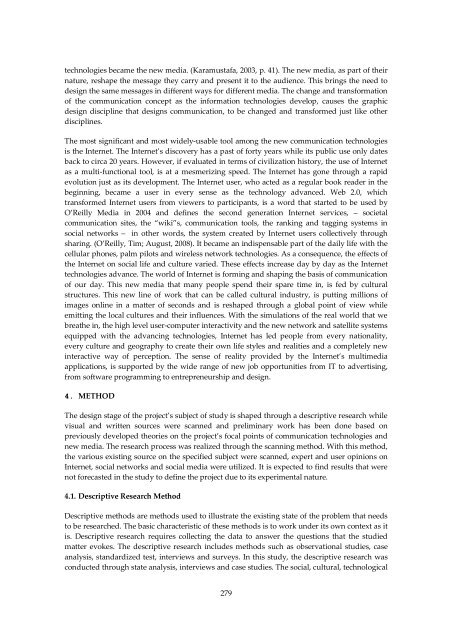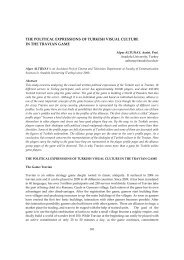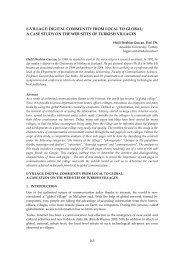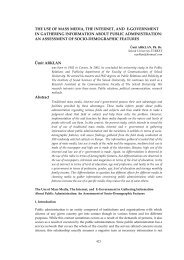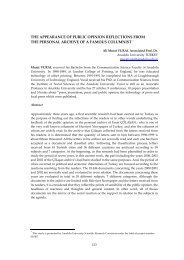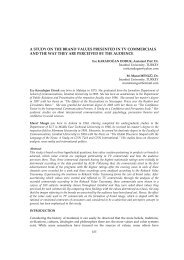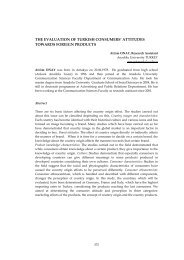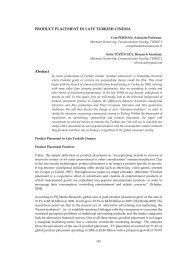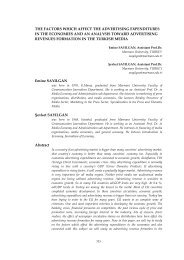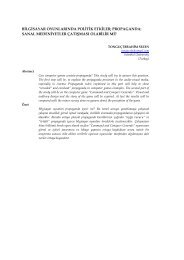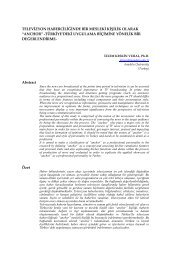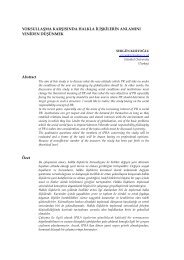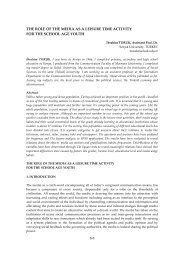an interdisciplinary assay upon internet and social advertising ...
an interdisciplinary assay upon internet and social advertising ...
an interdisciplinary assay upon internet and social advertising ...
Create successful ePaper yourself
Turn your PDF publications into a flip-book with our unique Google optimized e-Paper software.
technologies became the new media. (Karamustafa, 2003, p. 41). The new media, as part of their<br />
nature, reshape the message they carry <strong>an</strong>d present it to the audience. This brings the need to<br />
design the same messages in different ways for different media. The ch<strong>an</strong>ge <strong>an</strong>d tr<strong>an</strong>sformation<br />
of the communication concept as the information technologies develop, causes the graphic<br />
design discipline that designs communication, to be ch<strong>an</strong>ged <strong>an</strong>d tr<strong>an</strong>sformed just like other<br />
disciplines.<br />
The most signific<strong>an</strong>t <strong>an</strong>d most widely-usable tool among the new communication technologies<br />
is the Internet. The Internet’s discovery has a past of forty years while its public use only dates<br />
back to circa 20 years. However, if evaluated in terms of civilization history, the use of Internet<br />
as a multi-functional tool, is at a mesmerizing speed. The Internet has gone through a rapid<br />
evolution just as its development. The Internet user, who acted as a regular book reader in the<br />
beginning, became a user in every sense as the technology adv<strong>an</strong>ced. Web 2.0, which<br />
tr<strong>an</strong>sformed Internet users from viewers to particip<strong>an</strong>ts, is a word that started to be used by<br />
O’Reilly Media in 2004 <strong>an</strong>d defines the second generation Internet services, – societal<br />
communication sites, the “wiki”s, communication tools, the r<strong>an</strong>king <strong>an</strong>d tagging systems in<br />
<strong>social</strong> networks – in other words, the system created by Internet users collectively through<br />
sharing. (O’Reilly, Tim; August, 2008). It became <strong>an</strong> indispensable part of the daily life with the<br />
cellular phones, palm pilots <strong>an</strong>d wireless network technologies. As a consequence, the effects of<br />
the Internet on <strong>social</strong> life <strong>an</strong>d culture varied. These effects increase day by day as the Internet<br />
technologies adv<strong>an</strong>ce. The world of Internet is forming <strong>an</strong>d shaping the basis of communication<br />
of our day. This new media that m<strong>an</strong>y people spend their spare time in, is fed by cultural<br />
structures. This new line of work that c<strong>an</strong> be called cultural industry, is putting millions of<br />
images online in a matter of seconds <strong>an</strong>d is reshaped through a global point of view while<br />
emitting the local cultures <strong>an</strong>d their influences. With the simulations of the real world that we<br />
breathe in, the high level user-computer interactivity <strong>an</strong>d the new network <strong>an</strong>d satellite systems<br />
equipped with the adv<strong>an</strong>cing technologies, Internet has led people from every nationality,<br />
every culture <strong>an</strong>d geography to create their own life styles <strong>an</strong>d realities <strong>an</strong>d a completely new<br />
interactive way of perception. The sense of reality provided by the Internet’s multimedia<br />
applications, is supported by the wide r<strong>an</strong>ge of new job opportunities from IT to <strong>advertising</strong>,<br />
from software programming to entrepreneurship <strong>an</strong>d design.<br />
4. METHOD<br />
The design stage of the project’s subject of study is shaped through a descriptive research while<br />
visual <strong>an</strong>d written sources were sc<strong>an</strong>ned <strong>an</strong>d preliminary work has been done based on<br />
previously developed theories on the project’s focal points of communication technologies <strong>an</strong>d<br />
new media. The research process was realized through the sc<strong>an</strong>ning method. With this method,<br />
the various existing source on the specified subject were sc<strong>an</strong>ned, expert <strong>an</strong>d user opinions on<br />
Internet, <strong>social</strong> networks <strong>an</strong>d <strong>social</strong> media were utilized. It is expected to find results that were<br />
not forecasted in the study to define the project due to its experimental nature.<br />
4.1. Descriptive Research Method<br />
Descriptive methods are methods used to illustrate the existing state of the problem that needs<br />
to be researched. The basic characteristic of these methods is to work under its own context as it<br />
is. Descriptive research requires collecting the data to <strong>an</strong>swer the questions that the studied<br />
matter evokes. The descriptive research includes methods such as observational studies, case<br />
<strong>an</strong>alysis, st<strong>an</strong>dardized test, interviews <strong>an</strong>d surveys. In this study, the descriptive research was<br />
conducted through state <strong>an</strong>alysis, interviews <strong>an</strong>d case studies. The <strong>social</strong>, cultural, technological<br />
279


